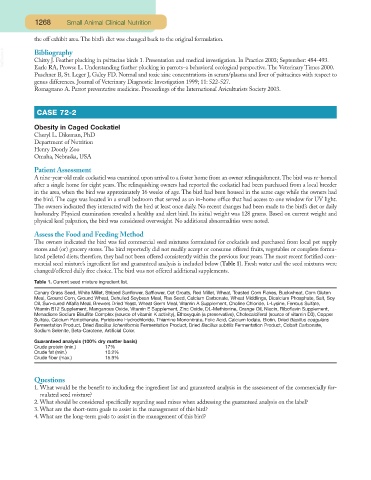Page 1218 - Small Animal Clinical Nutrition 5th Edition
P. 1218
1268 Small Animal Clinical Nutrition
the off exhibit area. The bird’s diet was changed back to the original formulation.
VetBooks.ir Bibliography
Chitty J. Feather plucking in psittacine birds 1. Presentation and medical investigation. In Practice 2003; September: 484-493.
Earle RA, Prowse L. Understanding feather plucking in parrots–a behavioral ecological perspective. The Veterinary Times 2000.
Puschner B, St. Leger J, Galey FD. Normal and toxic zinc concentrations in serum/plasma and liver of psittacines with respect to
genus differences. Journal of Veterinary Diagnostic Investigation 1999; 11: 522-527.
Romagnano A. Parrot preventative medicine. Proceedings of the International Aviculturists Society 2003.
CASE 72-2
Obesity in Caged Cockatiel
Cheryl L. Dikeman, PhD
Department of Nutrition
Henry Doorly Zoo
Omaha, Nebraska, USA
Patient Assessment
A nine-year-old male cockatiel was examined upon arrival to a foster home from an owner relinquishment.The bird was re-homed
after a single home for eight years. The relinquishing owners had reported the cockatiel had been purchased from a local breeder
in the area, when the bird was approximately 16 weeks of age. The bird had been housed in the same cage while the owners had
the bird. The cage was located in a small bedroom that served as an in-home office that had access to one window for UV light.
The owners indicated they interacted with the bird at least once daily. No recent changes had been made to the bird’s diet or daily
husbandry. Physical examination revealed a healthy and alert bird. Its initial weight was 128 grams. Based on current weight and
physical keel palpation, the bird was considered overweight. No additional abnormalities were noted.
Assess the Food and Feeding Method
The owners indicated the bird was fed commercial seed mixtures formulated for cockatiels and purchased from local pet supply
stores and (or) grocery stores. The bird reportedly did not readily accept or consume offered fruits, vegetables or complete formu-
lated pelleted diets; therefore, they had not been offered consistently within the previous four years.The most recent fortified com-
mercial seed mixture’s ingredient list and guaranteed analysis is included below (Table 1). Fresh water and the seed mixtures were
changed/offered daily free choice. The bird was not offered additional supplements.
Table 1. Current seed mixture ingredient list.
Canary Grass Seed, White Millet, Striped Sunflower, Safflower, Oat Groats, Red Millet, Wheat, Toasted Corn Flakes, Buckwheat, Corn Gluten
Meal, Ground Corn, Ground Wheat, Dehulled Soybean Meal, Flax Seed, Calcium Carbonate, Wheat Middlings, Dicalcium Phosphate, Salt, Soy
Oil, Sun-cured Alfalfa Meal, Brewers Dried Yeast, Wheat Germ Meal, Vitamin A Supplement, Choline Chloride, L-Lysine, Ferrous Sulfate,
Vitamin B12 Supplement, Manganous Oxide, Vitamin E Supplement, Zinc Oxide, DL-Methionine, Orange Oil, Niacin, Riboflavin Supplement,
Menadione Sodium Bisulfite Complex (source of vitamin K activity), Ethoxyquin (a preservative), Cholecalciferol (source of vitamin D3), Copper
Sulfate, Calcium Pantothenate, Pyridoxine Hydrochloride, Thiamine Mononitrate, Folic Acid, Calcium Iodate, Biotin, Dried Bacillus coagulans
Fermentation Product, Dried Bacillus licheniformis Fermentation Product, Dried Bacillus subtilis Fermentation Product, Cobalt Carbonate,
Sodium Selenite, Beta-Carotene, Artificial Color.
Guaranteed analysis (100% dry matter basis)
Crude protein (min.) 17%
Crude fat (min.) 10.2%
Crude fiber (max.) 15.9%
Questions
1. What would be the benefit to including the ingredient list and guaranteed analysis in the assessment of the commercially for-
mulated seed mixture?
2. What should be considered specifically regarding seed mixes when addressing the guaranteed analysis on the label?
3. What are the short-term goals to assist in the management of this bird?
4. What are the long-term goals to assist in the management of this bird?

